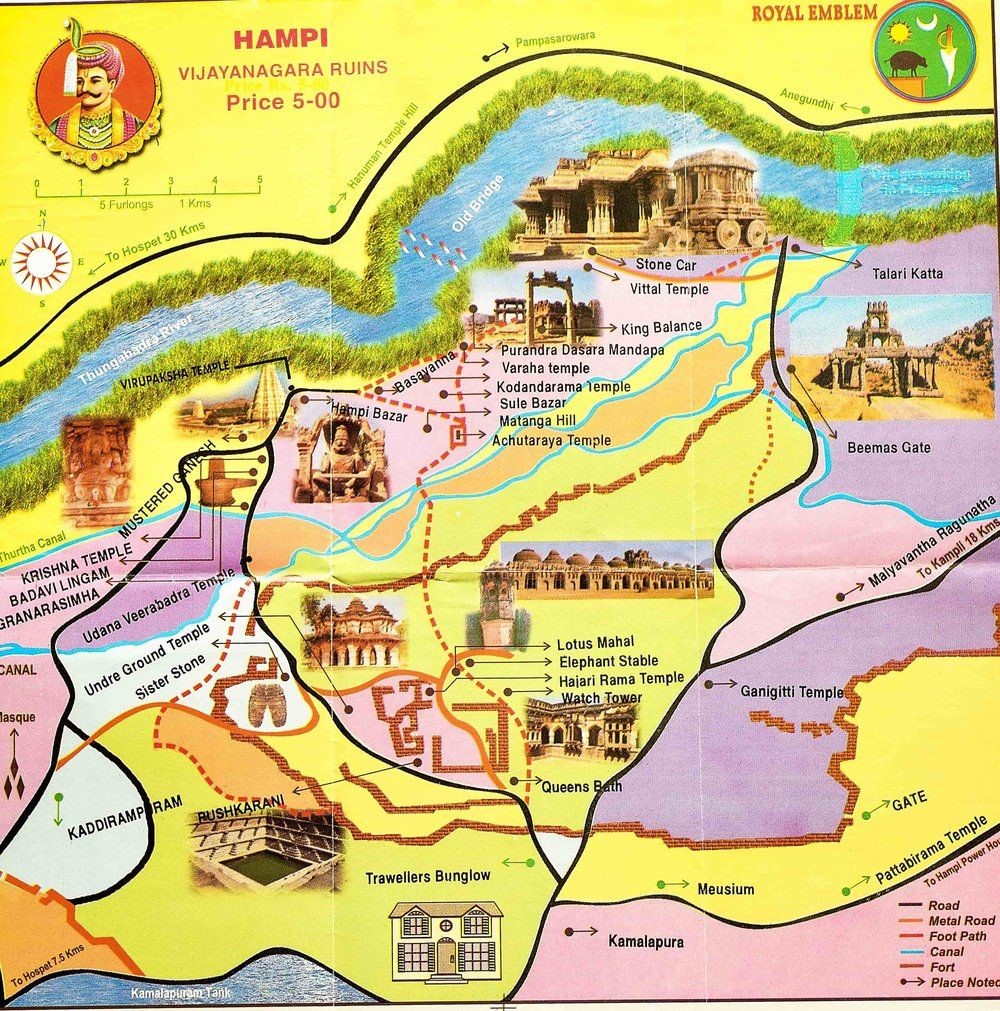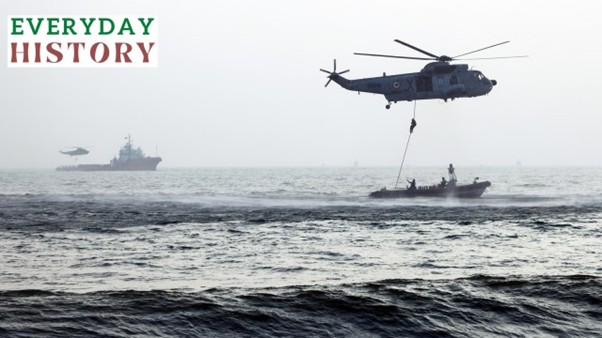




Disclaimer: Copyright infringement not intended.
A study on conservation of Hampi explores multifaceted efforts of conserving Hampi’s vast archaeological landscape while balancing concerns of local communities & stringent mandates of a UNESCO World Heritage Site.
|
Feature |
Details |
|
Founding |
Vijayanagara Empire was established in 1336 CE by Harihara I & Bukka Raya I of Sangama dynasty. |
|
Capital City |
Hampi (Vijayanagara) was imperial capital situated on banks of Tungabhadra River. |
|
Global Accounts |
Foreign travelers like Domingo Paes (Portuguese) in 1520 CE described it as as large & beautiful as Rome. |
|
Fall of Empire |
Defeated in Battle of Talikota (1565 CE) by Deccan Sultanates; capital ransacked & partially destroyed. |
|
Destruction & Abandonment |
The city reportedly burned for six months post defeat & was left largely untouched until rediscovered by British. |
|
Aspect |
Details |
|
Initial Mapping |
Colin Mackenzie (first Surveyor-General of India) mapped Hampi in 1799, created watercolour drawings. |
|
Photography |
Alexander Greenlaw took early photos in 1860s; documented ruins before excavations. |
|
Restoration Efforts |
British inserted steel rods into gopurams (e.g. Virupaksha Temple, marked Made in England 1856). |
|
Period |
Event |
|
1970s |
Directed by Saiyid Nurul Hasan, Union Minister; led to launch of Hampi National Project (1976). |
|
Core Excavations |
Excavation of Vitthala Bazaar, Royal Enclosures, Pushkarini tank & five bazaars. |
|
1986 |
Declared a UNESCO World Heritage Site. |
|
2022–Present |
Excavations resumed under Nikhil Das, ASI Hampi Circle; revealed Paan-Supari Bazaar. |
|
Factor |
Description |
|
Site Spread |
Over 250 sq. km includes around 1,600 monuments & 30 villages across Vijayanagara & Koppal districts. |
|
Governance |
Managed by ASI, Karnataka Archaeology Dept. & HWHAMA (formed post UNESCO warning in 1999). |
|
Zoning (2007) |
Area divided into Core Zone (40 sq.km), Buffer Zone (90 sq.km), Peripheral Zone (rest) with regulatory norms. |
|
Role |
Key Actions |
|
HWHAMA |
Formed in response to UNESCO placing Hampi on World Heritage in Danger List (1999) due to unauthorized bridge construction. |
|
Master Plan (2007) |
Enforced strict regulations; shops, guesthouses in core zones declared illegal; many were evacuated. |
|
Controversy |
Seen as non inclusive of locals & living heritage; caused displacement & loss of traditional livelihoods. |
|
Issue |
Insight |
|
Haphazard Excavations |
Archaeologists like Vasundhara Filliozat criticized lack of a systematic plan accidental discoveries led work. |
|
Temporary Suspension |
ASI suspended further digging to focus on conserving existing discoveries first. |
|
Inappropriate Restoration |
Eg. Narasimha monolith restoration halted after local protests; ASI replaced destroyed horse statues with elephants. |
|
Structural Vulnerability |
Example Saalu Mantapa at Virupaksha Temple collapsed due to heavy rains (2024) raising questions about neglect. |
|
Stakeholders |
Issues |
|
Local Villagers |
Over 30 villages exist within heritage site, many residents depend on tourism & trade. |
|
Evictions |
Hampi Bazaar (Virupaksha Temple) cleared in 2011 citing encroachments; locals lost livelihood. |
|
Cultural Impact |
Krishna Devaraya (descendant claim) & others argue for integrating traditional worship, temple priest residency & marketplaces. |
|
Rehabilitation |
Relocated villagers given homes & land elsewhere, but face disconnection from ancestral spaces. |
|
Factor |
Insight |
|
Tourist Footfall |
In 2023: 83,000 domestic & 20,000+ foreign visitors; economy now tourism-driven. |
|
Guides & Autos |
175 licensed guides; 300 auto-rickshaws operate within World Heritage zone. |
|
Environmental Concerns |
Poor sanitation, lack of green mobility & infrastructure strain raise red flags. |
|
INTACH Viewpoint |
Shama Pawar advocates for community inclusive planning, eco-sensitive tourism & better regulation. |
|
Name |
Role |
|
Harihara I & Bukka Raya I |
Founders of Vijayanagara Empire |
|
Domingo Paes |
Portuguese traveller (1520 CE) who documented Vijayanagara |
|
Colin Mackenzie |
First Surveyor-General of India, mapped Hampi in 1799 |
|
Alexander Greenlaw |
British photographer, 1860s Hampi documentation |
|
Saiyid Nurul Hasan |
Minister who initiated Hampi National Project (1976) |
|
George Michell |
Historian, founder of Deccan Heritage Foundation |
|
Nikhil Das |
Superintending Archaeologist, ASI Hampi Circle |
|
Shama Pawar |
INTACH, Hampi chapter convenor |
|
Krishna Devaraya |
Resident of Anegundi, claims royal descent |
|
Aspect |
Details |
|
Geographical Location |
Located in Ballari district Karnataka; lies along Tungabhadra River amidst rocky hills & granite outcrops. |
|
Cultural Significance |
Hampi is one of most important Shaivite & Vaishnavite pilgrimage sites; associated with Ramayana’s Kishkindha region. |
|
Architectural Style |
Primarily Dravidian architecture with elements of Indo-Islamic & temple-town planning (concentric enclosures, ceremonial axis, water structures). |
|
Unique Features |
Monolithic sculptures, musical pillars, stone chariots, stepwells (Pushkarinis), mantapas (pavilions), bazaar streets & water tanks. |
|
Famous Monuments |
Virupaksha Temple (oldest functioning temple in India) |
|
Sacred Geography |
Contains sacred shrines Kodanda Rama Temple, Yantrodharaka Hanuman Temple, Pampa Sarovar, Anjanadri Hill (birthplace of Hanuman). |
|
Inscriptions |
Inscriptions in Kannada, Telugu, Sanskrit, Tamil & even Persian; used for dating monuments & royal decrees. |
|
Water Management |
Advanced hydraulic system aqueducts, canals, cisterns & tanks like Kamalapura Tank, Bukka Aqueduct. |
|
Intangible Heritage |
Folk performances, temple rituals, Purandaradasa compositions, local craft traditions like stone carving, banana fiber craft. |
|
Festivals Celebrated |
Hampi Utsav/Vijaya Utsav Annual 3-day cultural event |
|
Associated Myths |
Believed to be monkey kingdom of Kishkindha in Ramayana; temples aligned with celestial & mythological beliefs. |
|
Current Tourism Issues |
Poor waste disposal |
|
Aspect |
Details |
|
Founding Dynasties |
The Empire saw four major dynasties |
|
Capital Cities |
Primary Vijayanagara (Hampi) |
|
Prominent Rulers |
Harihara I & Bukka Raya I (founders) |
|
Administrative System |
Centralized kingship with feudal Nayaka system |
|
Military Organization |
Large standing army with infantry, cavalry, war elephants |
|
Religion & Culture |
Patronized Shaivism, Vaishnavism, Jainism |
|
Language & Literature |
Flourished in Kannada, Telugu, Sanskrit, Tamil |
|
Economic Prosperity |
Major trade in spices, cotton, diamonds, horses |
|
Architectural Achievements |
Temple-town planning |
|
Art & Sculpture |
Featured intricate bas-reliefs, Yali pillars, musical pillars & mythological themes |
|
International Relations |
Diplomatic ties with Portuguese, Persians & horse trade from Arabian traders |
|
Downfall |
Battle of Talikota (1565 CE) Confederation of Deccan Sultanates (Bijapur, Ahmadnagar, Golconda, Berar, Bidar) |
For more such articles, please visit IAS GYAN
Sources:
|
PRACTICE QUESTION Q. How do architectural features of Hampi reflect socio-religious dynamics of Vijayanagara period? |


© 2025 iasgyan. All right reserved